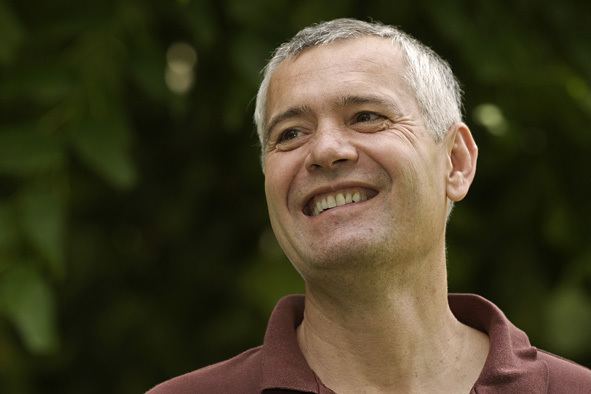Name George Driem | ||
 | ||
Born March 19, 1957 (age 68) ( 1957-03-19 ) Books Languages of the Himalayas, A grammar of Limbu, A grammar of Dumi, Dzongkha | ||
George van Driem | Wikipedia audio article
George (Sjors) van Driem (born 1957) is a linguist at the University of Berne, where he holds the chair of Historical Linguistics and directs the Linguistics Institute.
Contents
- George van Driem Wikipedia audio article
- Background
- Education
- Research
- Symbiomism
- Selected publications
- Awards and honours
- References

Background

George van Driem has conducted field research in the Himalayas since 1983. He was commissioned by the Royal Government of Bhutan to codify a grammar of Dzongkha, the national language, design a phonological romanisation for the language known as Roman Dzongkha, and complete a survey of the language communities of the kingdom. He and native Dzongkha speaker Karma Tshering co-authored the authoritative textbook on Dzongkha. Van Driem wrote grammars of Limbu and Dumi, Kiranti languages spoken in eastern Nepal, and the Bumthang language of central Bhutan. He authored Languages of the Himalayas, a two-volume ethnolinguistic handbook of the greater Himalayan region. Under a programme named Languages and Genes of the Greater Himalayan Region, conducted in collaboration with the Government of Nepal and the Royal Government of Bhutan, he collected DNA from many indigenous peoples of the Himalayas.
Education

Research
In Bern, George van Driem currently runs the research programme Strategische Zielsetzungen im Subkontinent (Strategic Objectives in the Subcontinent), which aims to analyse and describe endangered and poorly documented languages in South Asia. This programme of research is effectively a diversification of the Himalayan Languages Project, which he directed at Leiden University, where he held the chair of Descriptive Linguistics until 2009. He and his research team have documented over a dozen endangered languages of the greater Himalayan region, producing analytical grammars and lexica and recording morphologically analysed native texts.
His interdisciplinary research in collaboration with geneticists has led to advances in the reconstruction of Asian ethnolinguistic prehistory. Based on linguistic palaeontology, ethnolinguistic phylogeography, rice genetics and the Holocene distribution of faunal species, he identified the ancient Hmong-Mien and Austroasiatics as the first domesticators of Asian rice and published a theory on the homelands and prehistoric dispersal of the Hmong-Mien, Austroasiatic and Trans-Himalayan linguistic phyla. His historical linguistic work on linguistic phylogeny has replaced the unsupported Sino-Tibetan hypothesis with the older, more agnostic Tibeto-Burman phylogenetic model, for which he proposed the neutral geographical name Trans-Himalayan in 2004. He developed the Darwinian theory of language known as Symbiosism, and he is author of the philosophy of Symbiomism.
Symbiomism
Symbiomism is the philosophy of van Driem about mind and man’s place in nature that grew out of van Driem. Symbiosism is the linguistic theory that recognises language to be a memetic life form inhabiting the human brain. Human beings are unique symbiotic relationships in which the constituent symbionts are essentially different in nature. Our bodies furnish the hominid host for the human soul, whereby the soul is defined as all cognition that is directly or indirectly linguistically mediated. Man is a symbiome, a symbiotic union of body and soul. The question of our human identity is analogous to the organismal identity of lichens, green plants and all eukaryotic life. Countless such complex life forms arose evolutionarily as symbiomes. Man is as much his human body as he is the language that dwells within his brain and mediates much of his thinking. Good health is the state in which both constituent symbionts are healthy and abide in some sort of happy and wholesome equilibrium.
Symbiomism diagnoses religion to be a disease of language, recognises that opposition to religion per se might be an exercise in futility, and furnishes an analytical model for understanding the Darwinian mechanics by which cultural entities, pathological and benign, are propagated. Symbiomism furnishes a scientific culture theory for understanding human identity, studying individual and collective mental health and informing culture management. Religions, sects, ideologies, movements and myths can be channeled in benevolent ways in order to enhance individual well-being and further the common good. Legislators, policy makers, educational institutions, intelligence agencies and other memetic managers working within a symbiomist framework remain minimally interventionist and refrain from curtailing individual freedom of thought and expression.
